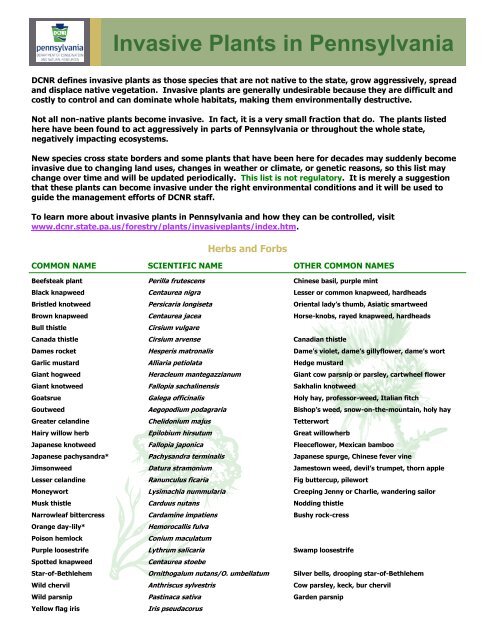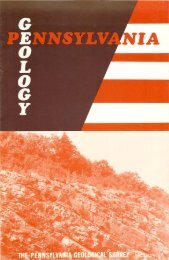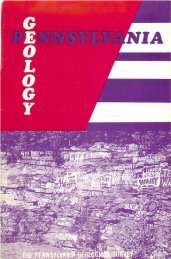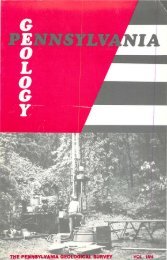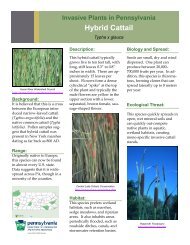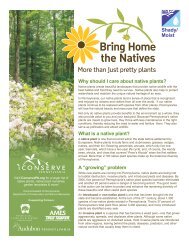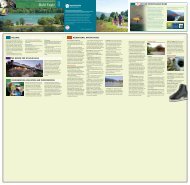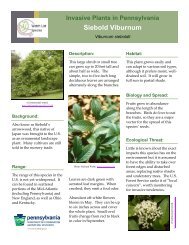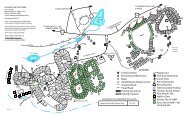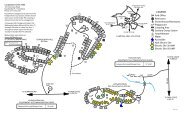Invasive Plants in Pennsylvania
Invasive Plants in Pennsylvania
Invasive Plants in Pennsylvania
Create successful ePaper yourself
Turn your PDF publications into a flip-book with our unique Google optimized e-Paper software.
<strong>Invasive</strong> <strong>Plants</strong> <strong>in</strong> <strong>Pennsylvania</strong><br />
DCNR def<strong>in</strong>es <strong>in</strong>vasive plants as those species that are not native to the state, grow aggressively, spread<br />
and displace native vegetation. <strong>Invasive</strong> plants are generally undesirable because they are difficult and<br />
costly to control and can dom<strong>in</strong>ate whole habitats, mak<strong>in</strong>g them environmentally destructive.<br />
Not all non-native plants become <strong>in</strong>vasive. In fact, it is a very small fraction that do. The plants listed<br />
here have been found to act aggressively <strong>in</strong> parts of <strong>Pennsylvania</strong> or throughout the whole state,<br />
negatively impact<strong>in</strong>g ecosystems.<br />
New species cross state borders and some plants that have been here for decades may suddenly become<br />
<strong>in</strong>vasive due to chang<strong>in</strong>g land uses, changes <strong>in</strong> weather or climate, or genetic reasons, so this list may<br />
change over time and will be updated periodically. This list is not regulatory. It is merely a suggestion<br />
that these plants can become <strong>in</strong>vasive under the right environmental conditions and it will be used to<br />
guide the management efforts of DCNR staff.<br />
To learn more about <strong>in</strong>vasive plants <strong>in</strong> <strong>Pennsylvania</strong> and how they can be controlled, visit<br />
www.dcnr.state.pa.us/forestry/plants/<strong>in</strong>vasiveplants/<strong>in</strong>dex.htm.<br />
Herbs and Forbs<br />
COMMON NAME SCIENTIFIC NAME OTHER COMMON NAMES<br />
Beefsteak plant Perilla frutescens Ch<strong>in</strong>ese basil, purple m<strong>in</strong>t<br />
Black knapweed Centaurea nigra Lesser or common knapweed, hardheads<br />
Bristled knotweed Persicaria longiseta Oriental lady’s thumb, Asiatic smartweed<br />
Brown knapweed Centaurea jacea Horse-knobs, rayed knapweed, hardheads<br />
Bull thistle Cirsium vulgare<br />
Canada thistle Cirsium arvense Canadian thistle<br />
Dames rocket Hesperis matronalis Dame’s violet, dame’s gillyflower, dame’s wort<br />
Garlic mustard Alliaria petiolata Hedge mustard<br />
Giant hogweed Heracleum mantegazzianum Giant cow parsnip or parsley, cartwheel flower<br />
Giant knotweed Fallopia sachal<strong>in</strong>ensis Sakhal<strong>in</strong> knotweed<br />
Goatsrue Galega offic<strong>in</strong>alis Holy hay, professor-weed, Italian fitch<br />
Goutweed Aegopodium podagraria Bishop’s weed, snow-on-the-mounta<strong>in</strong>, holy hay<br />
Greater celand<strong>in</strong>e Chelidonium majus Tetterwort<br />
Hairy willow herb Epilobium hirsutum Great willowherb<br />
Japanese knotweed Fallopia japonica Fleeceflower, Mexican bamboo<br />
Japanese pachysandra* Pachysandra term<strong>in</strong>alis Japanese spurge, Ch<strong>in</strong>ese fever v<strong>in</strong>e<br />
Jimsonweed Datura stramonium Jamestown weed, devil’s trumpet, thorn apple<br />
Lesser celand<strong>in</strong>e Ranunculus ficaria Fig buttercup, pilewort<br />
Moneywort Lysimachia nummularia Creep<strong>in</strong>g Jenny or Charlie, wander<strong>in</strong>g sailor<br />
Musk thistle Carduus nutans Nodd<strong>in</strong>g thistle<br />
Narrowleaf bittercress Cardam<strong>in</strong>e impatiens Bushy rock-cress<br />
Orange day-lily* Hemorocallis fulva<br />
Poison hemlock Conium maculatum<br />
Purple loosestrife Lythrum salicaria Swamp loosestrife<br />
Spotted knapweed Centaurea stoebe<br />
Star-of-Bethlehem Ornithogalum nutans/O. umbellatum Silver bells, droop<strong>in</strong>g star-of-Bethlehem<br />
Wild chervil Anthriscus sylvestris Cow parsley, keck, bur chervil<br />
Wild parsnip Past<strong>in</strong>aca sativa Garden parsnip<br />
Yellow flag iris Iris pseudacorus
V<strong>in</strong>es<br />
COMMON NAME SCIENTIFIC NAME OTHER COMMON NAMES<br />
Bigleaf periw<strong>in</strong>kle* V<strong>in</strong>ca major Greater periw<strong>in</strong>kle<br />
Black swallow-wort V<strong>in</strong>cetoxicum nigrum Louis’ or Louise’s swallow-wort<br />
Ch<strong>in</strong>ese wisteria* Wisteria s<strong>in</strong>ensis<br />
Chocolate V<strong>in</strong>e Akebia qu<strong>in</strong>ata Fiveleaf akebia, rais<strong>in</strong> v<strong>in</strong>e<br />
Common periw<strong>in</strong>kle* V<strong>in</strong>ca m<strong>in</strong>or Ground myrtle<br />
English ivy* Hedera helix Common ivy<br />
Japanese honeysuckle Lonicera japonica Ch<strong>in</strong>ese honeysuckle<br />
Japanese hops Humulus japonicus<br />
Japanese wisteria* Wisteria floribunda<br />
Kudzu Pueraria lobata V<strong>in</strong>e that ate the South<br />
Mile-a-m<strong>in</strong>ute Persicaria perfoliata Devil’s tear-thumb<br />
Oriental bittersweet Celastrus orbiculatus Asiatic or round-leaved bittersweet<br />
Pale swallow-wort V<strong>in</strong>cetoxicum rossicum European swallow-wort, dog strangl<strong>in</strong>g v<strong>in</strong>e<br />
Porcela<strong>in</strong> berry Ampelopsis brevipedunculata Amur pepperv<strong>in</strong>e, porcela<strong>in</strong> v<strong>in</strong>e<br />
W<strong>in</strong>tercreeper* Euonymus fortunei Climb<strong>in</strong>g Euonymus, fortune’s sp<strong>in</strong>dle<br />
Amur corktree* Phellodendron amurense<br />
Amur maple* Acer g<strong>in</strong>nala<br />
Bee-bee tree* Tetradium daniellii Korean Evodia<br />
Callery pear Pyrus calleryana Bradford pear<br />
Empress tree Paulownia tomentosa Pr<strong>in</strong>cess tree, royal paulownia<br />
European black alder Alnus glut<strong>in</strong>osa Common alder<br />
Japanese angelica tree Aralia elata<br />
Japanese corktree* Phellodendron japonicum<br />
Lavella corktree* Phellodendron lavallei Lavelle’s cork tree<br />
Mimosa Albizia julibriss<strong>in</strong> Persian silk tree, silktree, silky acacia<br />
Norway maple Acer platanoides<br />
Paper mulberry* Broussonetia papyfera<br />
Siberian elm Ulmus pumila<br />
Sycamore maple Acer pseudoplatanus Mock plane<br />
Tree-of-heaven Ailanthus altissima Ch<strong>in</strong>ese or st<strong>in</strong>k<strong>in</strong>g sumac, tree of hell<br />
White mulberry* Morus alba Common or Ch<strong>in</strong>ese or Russian white mulberry<br />
Brazilian water-weed Egeria densa<br />
Trees<br />
Aquatic <strong>Plants</strong><br />
Carol<strong>in</strong>a fanwort Cabomba carol<strong>in</strong>iana Green Cabomba, fish grass, Wash<strong>in</strong>gton grass<br />
Curly pondweed Potamogeton crispus Curly-leaved or curlyleaf or crispy-leaved pondweed<br />
Didymo Didymoshenia gem<strong>in</strong>ate Rock snot<br />
Eurasian water-milfoil Myriophyllum spicatum Eurasian milfoil, spike watermilfoil<br />
Europan water chestnut Trapa natans Devil pod<br />
Float<strong>in</strong>g seedbox Ludwigia peploides Water primrose<br />
Hydrilla Hydrilla verticillata Esthwaite waterweed<br />
Narrow-leaved cattail Typha angustifolia Narrow lead cattail, nail rod<br />
Parrot feather watermilfoil Myriophyllum aquaticum Parrotfeather
Shrubs<br />
COMMON NAME SCIENTIFIC NAME OTHER COMMON NAMES<br />
Amur honeysuckle Lonicera mackii<br />
Autumn olive Elaeagnus umbellata<br />
Bell’s honeysuckle Lonicera morrowii x bella Bella or showy bush or pretty honeysuckle<br />
Border privet Ligustrum obtusifolium Blunt-leaved or obtuse-leaved or regal privet<br />
Butterfly bush* Buddleja davidii Orange-eye butterfly bush<br />
Ch<strong>in</strong>ese bushclover Lespedeza cuneata Ch<strong>in</strong>ese Lespedeza, sericea lespedeza<br />
Ch<strong>in</strong>ese privet Ligustrum s<strong>in</strong>ense<br />
Common buckthorn Rhamnus cathartica Purg<strong>in</strong>g buckthorn<br />
Common privet Ligustrum vulgare European privet, wild privet<br />
Doublefile viburnum* Viburnum plicatum Japanese snowball bush<br />
European barberry Berberis vulgaris Common barberry<br />
Glossy buckthorn Frangula alnus<br />
Guelder rose Viburnum opulus Cranberrybush viburnum, red elder, cramp bark<br />
Japanese barberry Berberis thunbergii Red barberry, Thunberg’s barberry<br />
Japanese privet Ligustrum japonicum Waxleaf ligustrum, wax privet<br />
Japanese spiraea Spiraea japonica Japanese meadowsweet, nippon spiraea<br />
Jetbead Rhodotypos scandens Black jetbead<br />
L<strong>in</strong>den viburnum* Viburnum dilatatum L<strong>in</strong>den arrowwood<br />
Morrow’s honeysuckle Lonicera morrowii<br />
Multiflora rose Rosa multiflora Rambler or Japanese or baby or seven-sisters rose<br />
Russian olive Elaeagnus angustifolia Oleaster, wild olive<br />
Shrubby bushclover Lespedeza bicolor Shrubby lespedeza<br />
Siebold viburnum* Viburnum sieboldii Siebold’s arrowwood<br />
Standish honeysuckle Lonicera standishii<br />
Tartarian honeysuckle Lonicera tatarica<br />
W<strong>in</strong>eberry Rubus phoenicolasius W<strong>in</strong>e raspberry, Japanese w<strong>in</strong>eberry<br />
W<strong>in</strong>ged Euonymus Eunoymus alata Burn<strong>in</strong>g bush, w<strong>in</strong>ged burn<strong>in</strong>g bush, w<strong>in</strong>ged wahoo<br />
Grasses<br />
Cheatgrass Bromus tectorum Downy or droop<strong>in</strong>g brome, bronco grass, June grass<br />
Ch<strong>in</strong>ese silvergrass* Miscanthus s<strong>in</strong>ensis Eulalia, zebra grass, maidenhair grass<br />
Common reed Phragmites australis<br />
Golden bamboo* Phyllostachys aurea Yellow grove bamboo, fish pole bamboo<br />
Japanese stiltgrass Microstegium vim<strong>in</strong>eum Nepalese browntop, pack<strong>in</strong>g grass<br />
Johnson grass Sorghum halepense<br />
Ravenna grass* Saccharum ravennae Hardy pampas grass<br />
Reed canary grass Phalaris australis<br />
Rough bluegrass Poa trivialis<br />
Shattercane Sorghum bicolor ssp. x. drummondii<br />
Small carpetgrass * Anthraxon hispidus Jo<strong>in</strong>t-head grass, hairy jo<strong>in</strong>t grass, jo<strong>in</strong>thead<br />
Tall fescue* Schedonorus arund<strong>in</strong>aceus<br />
Wavyleaf basketgrass* Oplismenus hirtellus<br />
Species marked with an asterisk (*) are on DCNR’s “Watch List,” mean<strong>in</strong>g that they are still sold <strong>in</strong> the landscape and nursery<br />
trade but can act aggressively, are not very common throughout the state but are a problem <strong>in</strong> certa<strong>in</strong> locations, or are not yet <strong>in</strong><br />
<strong>Pennsylvania</strong> but are <strong>in</strong> neighbor<strong>in</strong>g states and would pose a major threat to our natural ecosystems should they arrive here.<br />
Many of these species can be difficult to eradicate once they have become established, so th<strong>in</strong>k twice before plant<strong>in</strong>g them. Keep<br />
an eye out for these species, remove them where possible, and consider choos<strong>in</strong>g native plants for your landscape.


